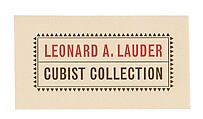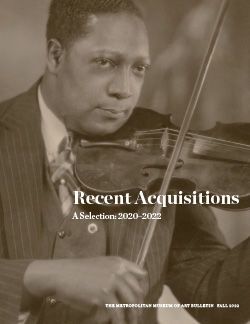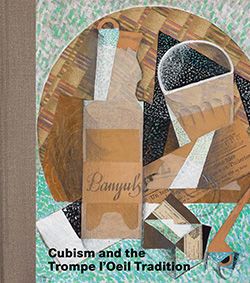Violin and Engraving
Juan Gris Spanish
Not on view
Violin and Engraving represents a rare example of Gris’s initial experiments with papiers collés before his breakthrough year in 1914. Gris left Madrid for Paris in 1906 and settled in the Bateau-Lavoir, a building in the Montmartre district that served as home and studio to several artists, including Pablo Picasso. There Gris witnessed the development of Cubism, while he supported himself initially as an illustrator. By 1911, he had begun to make a name for himself as a Cubist innovator, and a year later, developed his own signature canvases that were organized into grids of shifting vertical bands that would soon become diagonal or fan shaped. Such structures allowed him to produce taut but dynamic examinations of subjects from multiple positions. In early works of 1912 and 1913 he incorporated areas of solid color or textured brushwork with others filled with faux patterns (wood or wallpaper, for example)—what would, in later canvases, typically be filled with papier collé (pasted paper). While Picasso and Georges Braque had invented the papier collé technique, it was Gris who first exhibited a composition (The Washstand, 1912, private collection), at the 1912 Section d’Or exhibition at the Galerie la Boétie, Paris, where he received great critical attention for the "curious originality of [his] imagination."
Violin and Engraving is likely the fourth or fifth composition with papier collé that Gris produced. Like the preceding canvases that include part of a mirror, playing card, or page of a book, this work incorporates an element that represents what it is in life—in this case, a line engraving. What makes this work exceptional is the great conceptual investigation inspired by the collaged element: the print is after J.M.W. Turner’s watercolor, View of Saint Germain en Laye and its Chateau (ca. 1830, Musée du Louvre, Paris), which features a castle in the background and animated figures along the banks of the Seine. While it is unknown whether Gris directly saw this image, he likely came across its reproduction, perhaps as it was first published in the 1832 volume of The Keepsake, a popular illustrated literary anthology that ran from 1828–37. The print makes legible the activity on the shores, especially at center, where a man shows framed drawings to a woman and her small son. Selecting the image for his composition, Gris carefully trimmed the scene to focus in on the man presenting artworks; indeed, he is at the intersection of Gris’s cuts, nestled within an angle of paper. On the canvas, Gris framed the detail as an artwork and in doing so, engaged a series of repeated forms, from the doubled and shifted frame to the decorator’s nail and taut string (and their shadows) above. A reproduction of a watercolor, a painting of drawings, a frame within frames, presentation and representation—the treatment and significance of this collage element would have profound continued importance in Gris’s exploration of papier collé as a game with witty trompe l’oeil possibilities.
In an often-quoted letter from Gris to his dealer, Daniel-Henry Kahnweiler, dated just months after his completion of the painting, the artist shared a surprising response to a question likely raised by the purchaser (Michael Brenner of the New York gallery, Brenner and Coady) of Violin and Engraving, "You are right; in fact: as a matter of principle the picture must be left just as it is. But once Mr. Brenner is the owner of the picture, he is at liberty to substitute something else for this engraving—even his portrait if he likes. It may look better, or it may look worse, as when one chooses a frame for a picture; but it won’t upset the merits of the picture."
Given the selection of the engraving, its careful editing and placement, and the layers of meaning it inspires about reproduction and what one sees, Gris’s response must have been full of irony.
This image cannot be enlarged, viewed at full screen, or downloaded.
This artwork is meant to be viewed from right to left. Scroll left to view more.





